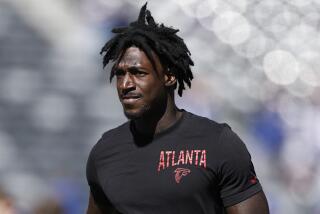Drug Charge Clouds Reilly’s Boxing Future
- Share via
Pepe Reilly of Glendale, the national amateur boxing champion in the 147-pound division, could be ineligible for the U.S. Olympic Festival, the Pan American Games and the World Championships this year and might also miss the 1992 U.S. Boxing Championships after being suspended for allegedly using an anabolic steroid.
The action, announced Monday by the USA Amateur Boxing Federation, also could mark the end of Reilly’s dream of competing in the 1992 Olympics in Barcelona.
Reilly, 19, has appealed the suspension, according to ABF spokesman Jay Miller, and the appeal will be formally received by the ABF later this week. The appeal will be heard by the ABF’s board of directors at a meeting in Los Angeles on July 13, Miller added.
“Because of the appeal process, the ABF is no longer at liberty to discuss the case or to speculate as to what might happen,” Miller said.
If it stands, the suspension would ban Reilly from all ABF-sanctioned bouts until March 7, 1992. In addition to being banned from all of the major competitions this year, Reilly would not be eligible to compete again until just six weeks before the U.S. Olympic Trials, scheduled for June 20-24 of next year, during which the Olympic team will be determined.
A nine-month layoff ending just prior to the Olympic Trials would make it difficult for Reilly to win a berth on the U.S. Olympic team.
Reilly made a remarkable weight gain during the 12 months leading up to the U.S. Championships in March, in which he captured the 147-pound title. Just a year earlier, in the 1990 championships, he weighed 119 pounds.
In 1988, he weighed only 106 pounds.
The routine drug test administered to all boxers after the national championships in March allegedly revealed traces of the anabolic steroid Nandrolone in Reilly’s urine, according to the ABF’s National Board of Review.
“A 30-pound weight gain in 12 months sounds about right for Nandrolone,” said Dr. Robert Voy, the chairman of the ABF’s Sports Medicine Committee. “It is one of the most common anabolic steroids in use by athletes and bodybuilders.”
Nandrolone is injected, according to Voy, and is sold as Deca Durabolin. It is a Class 3 drug in the United States, legally obtainable only with a doctor’s prescription. But Voy said Nandrolone is among the more common steroids on the black market.
Dr. James Puffer of UCLA, the head physician for the 1988 U.S. Olympic team, said Nandrolone has become less common in the past few years because it is an easy anabolic steroid to detect during drug testing.
“It can be detected for quite some time, several months actually, after being used,” Puffer said. “And because this drug hangs around for such a long time, most athletes . . . most athletes knowledgeable in the abuse of anabolic steroids, have switched to other forms.
“It was not detected during the 1988 Olympics because athletes by then knew that by using it they were almost certain to be caught.”
Puffer said the drug is readily available over the counter at many pharmacies in Mexico. It is seldom prescribed by doctors and has very limited therapeutic value, he said, being used occasionally to treat an anemic patient or a burn victim, when quick regeneration of tissue is desired.
Reilly, who is 5-foot-10, told The Times in April that his astounding jump from the 119- to 147-pound weight class was the result of natural growth.
“I’ve just been eating a lot more than I ever did and working out harder,” he said during an interview. “And I’m just 19. I guess it was just one of those growth spurts.”
Neither Reilly nor his father and trainer, Fred Reilly, was available Tuesday for comment.
More to Read
Go beyond the scoreboard
Get the latest on L.A.'s teams in the daily Sports Report newsletter.
You may occasionally receive promotional content from the Los Angeles Times.










